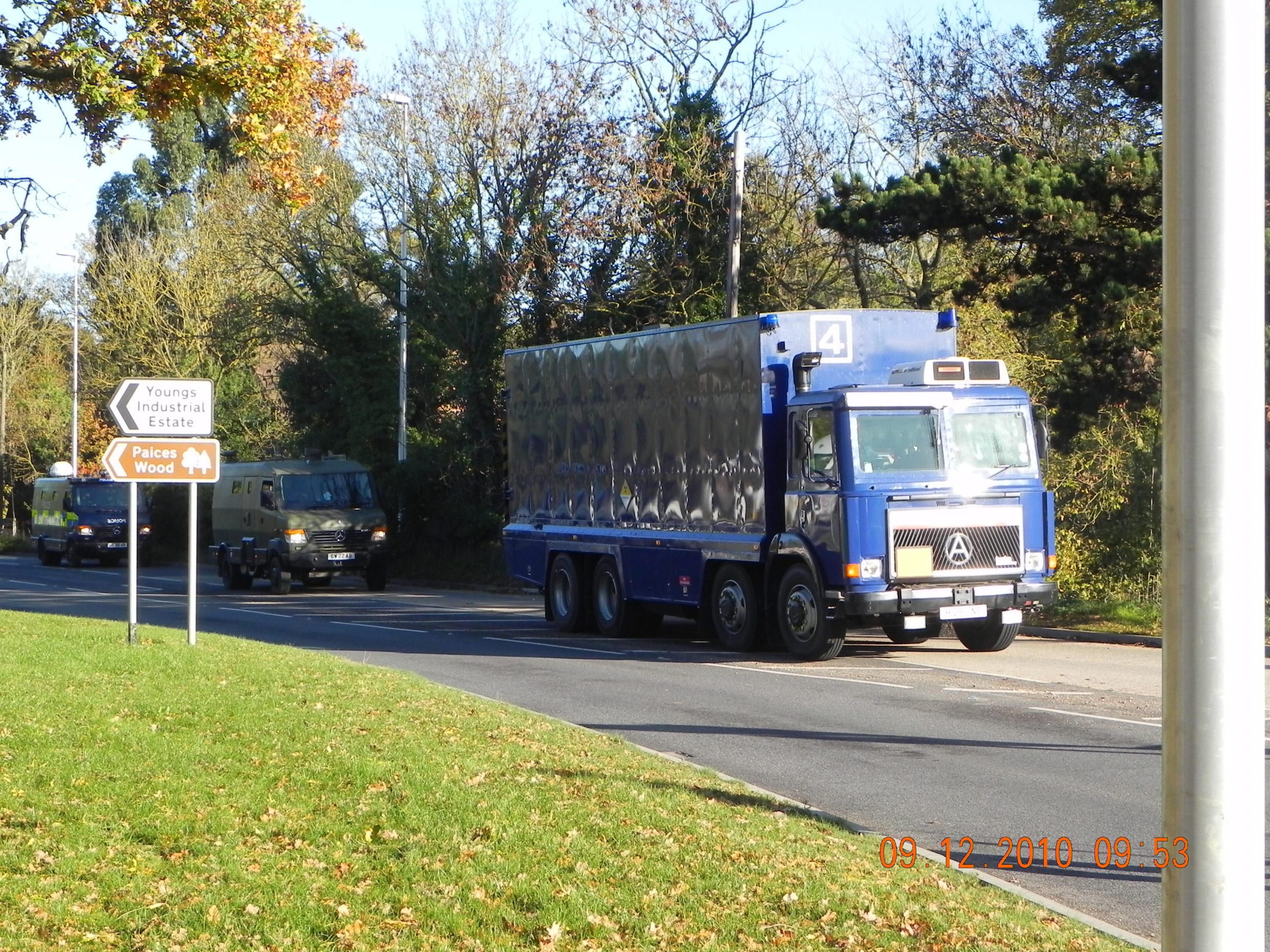Ministry of Defence High Security Vehicle returning to AWE Aldermaston in 2010 following a clutch failure (Photo: Nukewatch)
Cargoes of highly radioactive military nuclear materials are being transported along British roads in ageing Ministry of Defence (MoD) trucks which are regularly experiencing breakdowns and safety shortfalls because of delays in arranging for new vehicles to take over their duties.
Papers released under the Freedom of Information Act reveal that MoD is continuing to use special High Security Vehicles which are over 20 years old to transport military special nuclear materials to and from the Atomic Weapons Establishment in Berkshire, where the UK's nuclear weapons and fuel for nuclear powered submarines are manufactured, even though the vehicles were scheduled to have been replaced in 2010.
A log of safety incidents provided to Nuclear Information Service by the Ministry of Defence in response to a Freedom of Information request (available to download at the bottom of this article) reveals that the vehicles have suffered a series of breakdowns and faults since 2010.
In November 2010 a special nuclear materials convoy was forced to return to AWE Aldermaston after setting out because the clutch of the High Security Vehicle in the convoy kept slipping as a result of “wear and tear”. The convoy set out again later the same day with a replacement truck substituting for the defective vehicle.
On another convoy run in November 2012 the alternator on one of the vehicles failed. The convoy was diverted to a nearby Ministry of Defence establishment for repairs, resulting in a 50 minute delay to the journey.
Other faults were experienced in December 2010 when a tail lift failed to operate, in November 2011 when a vehicle suffered a minor fuel leak while on the road, and in June 2012 when a flat battery required a vehicle to be slave started. Each of the faults resulted in a “minor delay” to convoy journeys.
The problems have occurred despite “comprehensive HSV servicing and maintenance routines” which, according to a monthly status brief on the project to replace the vehicles, are now necessary “to minimise risk of breakdown / malfunction”.
The MoD fleet of two High Security Vehicles for the transport of special nuclear materials consists of two H-registered Seddon Atkinson vehicles which entered into service in 1991.
An assessment undertaken by MoD in 2006 indicated that the vehicles would reach the end of their operating life in 2009 – itself an extension of an out of service date previously estimated as 2003. The assessment stated that the vehicles would become “increasingly unsupportable” if operated beyond 2009.
A year later the MoD's Nuclear Movements Integrated Project Team decided to adopt a new solution for the transport of special nuclear material containers: shipment on special pallets in another fleet of specialized vehicles built to carry nuclear warheads. The new arrangements were scheduled for “full operating capability” by October 2010, allowing the High Security Vehicles to be withdrawn from service soon afterwards.
The decision to use warhead transporters in the new role was taken despite a warning in the 2006 assessment that “the combined vehicle approach does not provide a practicable solution for a replacement HSV” because of access issues at military bases, practicalities of materials movement timetables, and MoD policy that the two types of convoy should appear different.
Delays in the programme to withdraw the High Security Vehicles from service appears to have resulted from setbacks in the preparation and approval of safety cases required to allow new vehicles designed to carry nuclear warheads to take over the transport of special nuclear material cargoes.
The Ministry of Defence has stated that the out of service date for the High Security Vehicle “depends on a number of factors” and is current;y expected to be “around late 2014 to early 2015”.
The two High Security Vehicles regularly transport special nuclear materials – plutonium, tritium, and highly enriched uranium – and nuclear warhead components between the two Atomic Weapons Establishment sites at Aldermaston and Burghfield in Berkshire. They also transport highly enriched uranium pellets for use in submarine reactor fuel from Aldermaston to a factory operated by Rolls-Royce Marine Power Operations Ltd in Derby where fuel modules for Astute class nuclear powered submarines are manufactured.
The vehicles are also used to deliver radioactive materials and components provided by the USA to Aldermaston from RAF Brize Norton – the airhead to which they are flown across the Atlantic.
Download papers released by the Ministry of Defence in response to our Freedom of Information request here:
